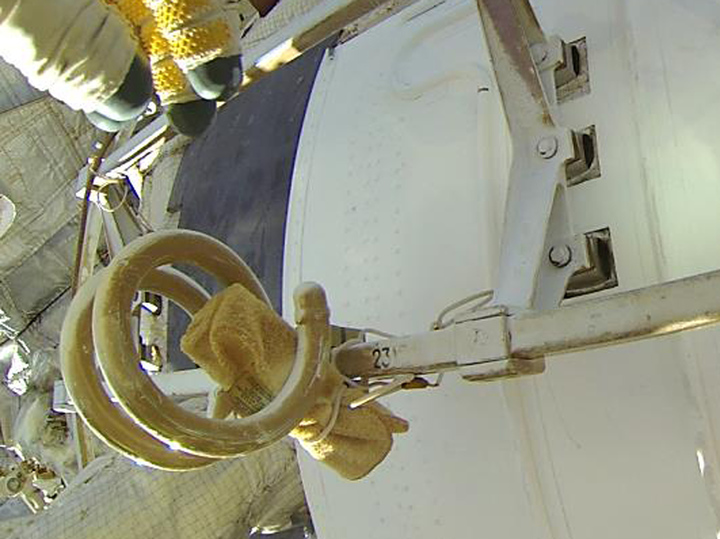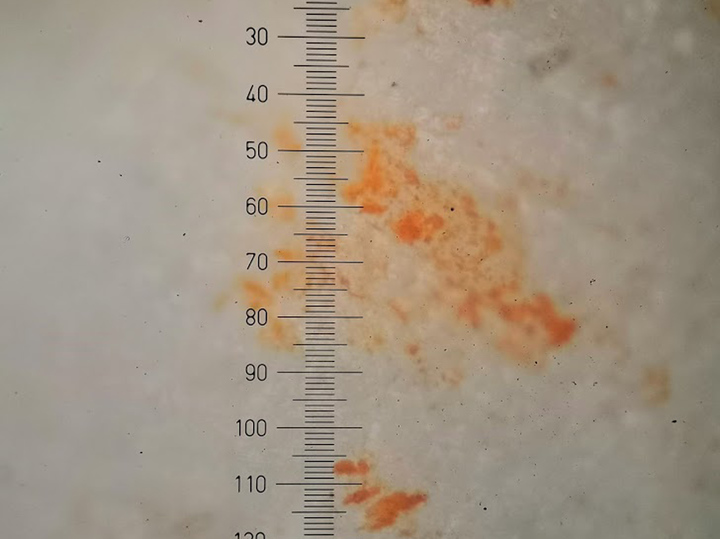Russian scientists explored a “space towel” with dust from the ISS
[ad_1]
First, the backstory. In the yard, that is, in orbit, May 15, 2019. Russian cosmonauts Oleg Kononenko and Alexei Ovchinin work under the EVA (extravehicular activity) program, and returning to the station, they take with them a terry towel neatly tied to one of the handrails 10 years ago. A similar material is commonly used by astronauts to clean spacesuit gloves after contact with toxic fuel residues that remain on the surface of the modules.

This bundle of fabric was left on December 23, 2008 by Yuri Lonchakov and American cosmonaut Michael Fink on bracket 2312 during an EVA session (Michael Fink even left his autograph on the inside of the fabric). Kononenko and Ovchinin were given the task of taking the “object” that turned red over time with them. Inside the station, they packed it in a sealed container, and after descent, in September 2019, they handed it over to scientists for research. It was interesting to check the composition of the contamination of the fabric, and, accordingly, the external surface of the station, accumulated on them over a decade, and the possible connection of polluting factors with the existing microdamages of the station hull.
ISS under power
Russian scientists have been actively working on the problem of such microdamages since the 1980s. For example, in the department of hydroacoustics of VNIIFTRI, a “pocket” version of the Leak Indicator device was developed and manufactured to detect a possible air leak at the Mir station. Starting from 2008, in connection with the discovery of many foci of corrosion on the inner surface of the ISS pressurized hull, it was decided to develop scientific equipment for fixing the deformation of the pressurized hull by propagating acoustic waves. The technical project for the instruments placed inside the station was carried out by the employees of the Research Department of Acousto-Optical Measurements and Laser Optoelectronics of the Institute (this department was formed on the basis of a laboratory founded in 1966 by the outstanding academician Vladislav Pustovoit).
According to the deputy head of the department Vladimir Belyaev, the scientists came to the conclusion that a small destruction can occur inside the space station body due to internal pressure, dampness, the operation of the station’s life support systems and temperature fluctuations.
DNA of bacteria found on the surface of the station
– Did you initially have assumptions about sources of pollution from the outside of the ISS? I ask Belyaev.
We assumed three possible sources from which reddish or gray spots appear at the station. Extraterrestrial dust was considered among the first. “If we study it, we can find out what the cosmos is made of!” we anticipated. The second assumption was based on terrestrial origin, since swabs from the outer surface of the ISS, taken earlier, showed the presence of terrestrial microorganisms. At different times, as part of the “Test” experiment, the DNA of bacteria found in the soil of Madagascar and the DNA of bioplankton bacteria from the Barents Sea were found. And by X-ray photoelectron spectroscopy, scientists discovered rhenium. This element is present in volcanic eruptions. We have an assumption that jets could become a kind of elevator for delivering earth particles to a height of 400 kilometers (lightning discharges from a thundercloud not towards the Earth, but towards the sky – Auth.). Thirdly, we hoped that we would find traces of all kinds of its own emissions on the surface of the station, which form the outer atmosphere of the ISS. For example, dust sludge may contain spent fuel condensate materials and many other associated pollutants that can cause process deposits. This sediment may even contain particles of materials of the ISS body, which are formed as a result of microdamages of structural elements.

– So what was there more?
– Most of all, there were microparticles of aluminum (the main structural material of the ISS) and silicon (a component of solar panels and quartz glass). Further in descending order are: iron, magnesium, zinc and other elements, but in smaller quantities.
What the towel “told”
– Did the piece of terry cloth returned by the astronauts, which had accumulated pollution over ten years, confirmed the previously obtained results?
– Yes, it looks like it, – Aleksey Pryadka, the engineer of the department, joins the conversation. “Actually, there were some difficulties with him. Firstly, cotton fabric is not ideal for such experiments, because it is made from a natural material, which itself has a rich mineral composition. Secondly, it was packed in a container not in outer space, but inside the living compartment, which also violates the purity of the experiment; thirdly, we did not have a control sample, because the towel left in space was used by us as a “trap” for external contamination by pure chance.
– And yet, what did it “tell” you about?
“We immediately noticed the partial destruction of the tissue itself. It looked like the result of an intense impact, for example, by a fast-flying cosmic particle, says Belyaev. – In order to check this version, we involved employees of the Physicochemical Institute of the Russian Academy of Sciences, who made an X-ray diffraction analysis of the samples. But he showed that there are no crystalline particles expected by us in the towel. Perhaps their substance had time to evaporate over time.
– And how did you “extract” other elements from the towel?
“The sample was first dried, then weighed, and then this cloth was dissolved to a liquid state in a mixture of hydrochloric, hydrofluoric and nitric acids in a microwave field,” explains Alexey Pryadka. – The fact is that our device – an optical spectrometer – works only with solutions. Along with it, a nuclear reactor was connected to the study, which is located at JINR, in Dubna. As a result, in contrast to our previous studies of contaminants on the outside of the station, we found more iron in the towel. There were in it in insignificant, but still detectable quantities, completely new substances, for example, thorium and uranium. We assumed that the cotton from which the towel was sewn could be grown in an area located near the sites of nuclear tests.
– How did you explain the presence of a large amount of iron?
“It put us in a dead end,” says Vladimir Belyaev. – First we decided to check the version of the meteorite substance. But, correlating iron and nickel, they came to the conclusion that it has nothing to do with meteorites. Our version also crashed about stone meteorites. There remains only the possibility that their traditional components: silicon, phosphorus, arsenic, antimony, copper, etc. may be components of terrestrial dust.
– Was there a component that you did not expect to find in the study?
“We found iridium, but it turned out to be too little for meteorites and too much for terrestrial content. We paid attention to rare earth elements, which just do not fly from anywhere. For example, zinc and titanium are very dispersed elements and there are relatively many of them in the tissue. We also found traces of rhenium. It can only be evidence of terrestrial transfer, because there is no rhenium either at the station itself or in space. But there is a lot of it in the volcano “Kudryavy” on the island of Iturup. There is so much rhenium that there is already a question about its industrial production. It is used, for example, for the production of catalysts, for microelectronics.
In general, it became clear to us that the precipitation on the outer side of the ISS, including the towel, is taken from all three sources we assumed. But still, another question interested me most of all: why, with these sources of pollution, are there still many clean surfaces on the ISS?
– Is there a version of the answer?
– There is a working explanation that they are bleached by solar radiation – it kind of evaporates the dirt. One fact prompted me to this version: all contaminated places of handrails or other parts of the modules “look” inward, and clean ones look outward.
Interestingly, NASA is only now interested in the problem of pollution and the presence of life, that is, microorganisms, on the outer surface of the station. This means that Russian scientists, who began their “inventory” seven years ago, again found themselves ahead in the whole direction of scientific research.
[ad_2]
Source link








